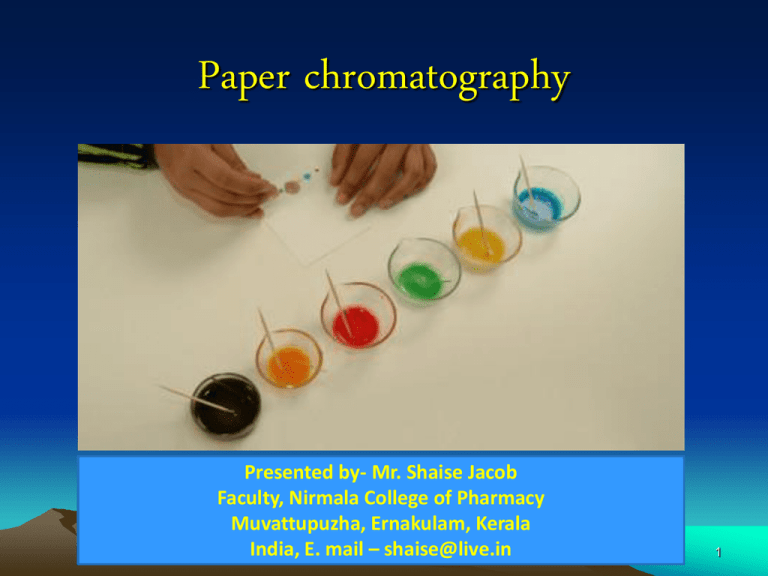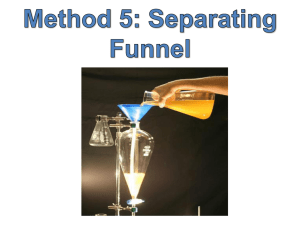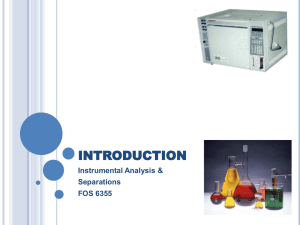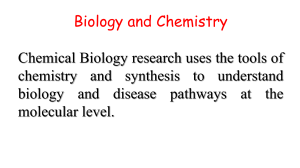PAPER CHROMATOGRAPHY
advertisement

Paper chromatography Presented by- Mr. Shaise Jacob Faculty, Nirmala College of Pharmacy Muvattupuzha, Ernakulam, Kerala India, E. mail – shaise@live.in 1 PAPER CHROMATOGRAPHY • Paper Chromatography (PC) was first introduced by German scientist Christian Friedrich Schonbein (1865). • PC is considered to be the simplest and most widely used of the chromatographic techniques because of its applicability to isolation, identification and quantitative determination of organic and inorganic compounds. 2 PAPER CHROMATOGRAPHY • ANALYSIS OF UNKNOWN SUSTANCES It is carried out mainly by the flow of solvents on specially designed filter paper. There are two types of paper chromatography, they are: 3 PAPER CHROMATOGRAPHY 1.PAPER ADSORPTION CHROMATOGRAPHY Paper impregnated with silica or alumina acts as adsorbent (stationary phase) and solvent as mobile phase. 2.PAPER PARTITION CHROMATOGRAPHY Moisture / Water present in the pores of cellulose fibers present in filter paper acts as stationary phase & another mobile phase is used as solvent In general P.C – Paper Partition Chromatography 4 PAPER CHROMATOGRAPHY PRINCIPLE OF SEPERATION The principle of separation is mainly partition rather than adsorption. Cellulose layers in filter paper contains moisture which acts as stationary phase & organic solvents/buffers are used as mobile phase 5 PAPER CHROMATOGRAPHY • • • • • • PRACTICAL REQUIREMENTS 1)Stationary phase & papers used 2)Application of sample 3)Mobile phase 4)Development technique 5)Detecting or Visualizing agents 6 PAPER CHROMATOGRAPHY • STATIONARY PHASE AND PAPERS USED Whatman filter papers of different grades like No.1, No.2, No.3, No.4, No.20, No.40, No.42 etc are used. In general this paper contains 98-99% of α-cellulose, 0.3 – 1% β -cellulose Factors that governs the choice of paper: » Nature of Sample and solvents used. » Based on Quantitative or Qualitative analysis. » Based on thickness of the paper. 7 PAPER CHROMATOGRAPHY • Modified Papers – acid or base washed filter paper, glass fiber type paper. • Hydrophilic Papers – Papers modified with methanol, formamide, glycol, glycerol etc. • Hydrophobic papers – acetylation of OH groups leads to hydrophobic nature, hence can be used for reverse phase chromatography. • Impregnation of silica, alumna, or ion exchange resins can also be made. 8 PREPARATION OF PAPER • • • Cut the paper into desired shape and size depending upon work to be carried out. The starting line is marked on the paper with an ordinary pencil 5cm from the bottom edge. On the staring line marks are made 2cm apart from each other. 9 PAPER CHROMATOGRAPHY • Preparation of the solution • Choice of suitable solvent for making solution is very important. Pure solutions can be applied direct on the paper but solids are always dissolved in small quantity of a suitable solvent. • Biological tissues are treated with suitable solvents and their extracts obtained. Proteins can be precipitated with alcohol and salts can be removed by treatment with ion exchange resin. 10 PAPER CHROMATOGRAPHY APPLICATION OF SAMPLE The sample to be applied is dissolved in the mobile phase and applied as a small spot on the origin line, using capillary tube or micropipette. very low concentration is used to avoid larger zone • The spot is dried on the filter paper and is placed in developing chamber. 11 Choice of the Solvent • The commonly employed solvents are the polar solvents, but the choice depends on the nature of the substance to be separated. • If pure solvents do not give satisfactory separation, a mixture of solvents of suitable polarity may be applied. 12 PAPER CHROMATOGRAPHY • • • • • • MOBILE PHASE Pure solvents, buffer solutions or mixture of solvents Examples- Hydrophilic mobile phase Isopropanol: ammonia:water 9:1:2 Methanol : water 4:1 N-butanol : glacial acetic acid : water 4:1:5 Hydrophobic mobile phases dimethyl ether: cyclohexane kerosene : 70% isopropanol 13 CHROMATOGRAPHIC CHAMBER The chromatographic chamber are made up of many materials like glass, plastic or stainless steel. Glass tanks are preferred most. They are available in various dimensional size depending upon paper length and development type. The chamber atmosphere should be saturated with solvent vapor. 14 PAPER CHROMATOGRAPHY DEVELOPMENT TECHNIQUE • Paper is flexible when compared to glass plate used in TLC, several types of development are possible which increases the ease of operation. • The paper is dipped in solvent in such a manner that the spots will not dip completely into the solvent. • The solvent will rise up and it is allowed to run 2/3rd of paper height for better and efficient result. 15 PAPER CHROMATOGRAPHY • Different types of development tech. are 1) ASCENDING DEVELOPMENT (go up) • Like conventional type, the solvent flows against gravity. The spots are kept at the bottom portion of paper and kept in a chamber with mobile phase solvent at the bottom. 16 PAPER CHROMATOGRAPHY • 2) DESCENDING TYPE (a downward slope) • This is carried out in a special chamber where the solvent holder is at the top. The spot is kept at the top and the solvent flows down the paper. • In this method solvent moves from top to bottom so it is called descending chromatography. • ADVANTAGE IS THAT, DEVELOPMENT IS FASTER 17 PAPER CHROMATOGRAPHY 3)ASCENDING – DESCENDING DEVELOPMENT A hybrid of above two technique is called ascending-descending chromatography. Only length of separation increased, first ascending takes place followed by descending 18 PAPER CHROMATOGRAPHY 4)CIRCULAR / RADIAL DEVELOPMENT Spot is kept at the centre of a circular paper. The solvent flows through a wick at the centre & spreads in all directions uniformly. 19 PAPER CHROMATOGRAPHY 5)TWO DIMENSIONAL DEVELOPMENT In this method the paper is developed in one direction and after development, the paper is developed in the second direction allowing more compounds to be separated into individual spots. in the second direction, either same solvent/different solvent system can be used for development. 20 TWO DIMENSIONAL DEVELOPMENT 21 PAPER CHROMATOGRAPHY DRYING OF CHROMATOGRAM • After the solvent has moved a certain distance for certain time the chromatogram is taken out from the tank & position of the solvent front is marked with a pencil. • They are dried by cold or hot air depending on volatility of solvents. A simple hair dryer is a convenient device to dry chromatograms. 22 PAPER CHROMATOGRAPHY DETECTING / VISUALISING AGENTS If the substance are colored they are visually detected easily. But for colorless substance, Physical and chemical methods are used to detect the spot. (a) Non specific methods ( Physical methods) E.g. iodine chamber method, UV chamber for fluorescent compounds – at 254 or at 365nm. 23 (b) Specific methods (Chemical methods) or Spraying method - examples, • Ferric chloride • Ninhydrin in acetone • Dragendroff’s reagents • 3,5 dinitro benzoic acid • Phenolic comp. & tannins • Amino acids • Alkaloids • Cardiac glycosides 24 Following detecting tech. can also be categorized as • 1) Destructive techniques • Specific spray reagents, samples destroyed before detection e.g. – ninhydrin reagent • 2) Non-destructive techniques • For radio active materials - Geiger Muller counter • uv chamber, iodine chamber QUANTITATIVE ESTIMATIONS The method can be divided into two main groups 1. Direct techniques2. Indirect techniques25 PAPER CHROMATOGRAPHY • • • • • • Direct Measurement Method (i) Comparison of visible spots A rough quantitative measurements Component in a mixture can be carried out by comparing the intensity and size of the spot with a standard substance. (ii) Photo densitometry The method is used with the chromatograms of colored compound, instrument which measures quantitatively the density of the spots. 26 PAPER CHROMATOGRAPHY • (iii) Fluorimetry • The compound to be determined by fluorimetry must be fluorescent or convertible into fluorescent derivatives. • (iv) Radiotracer Method • The compound containing radioactive element is labeled and treated with locating reagent. Using Geiger Muller counter. • (v) Polarographic & Conductometric methods • Used to measure the amount of material in the spot 27 PAPER CHROMATOGRAPHY • Indirect Measurement Method • In this technique, the spots are cut into portions and eluted with solvents. This solution can be analyzed by any techniques of analysis like spectrophotometry, electrochemical methods, etc. 28 Rf VALUE (Retardation Factor) In paper chromatography the results are represented by Rf value which represent the movement or migration of solute relative to the solvent front. 29 Factors affecting Rf VALUE • i. The temperature • ii. The purity of the solvents used • iii. The quality of the paper, adsorbents & impurities present n the adsorbents • iv. Chamber saturation techniques, method of drying & development • v. The distance travelled by the solute & solvent • vi. Chemical reaction between the substances being partitioned. • vii. pH of the solution 30 Rx VALUE • In many cases it has been observed that the solvent front is run off the end of the paper. Rx value is thus used, • It is the ratio of distance travelled by the sample and the distance travelled by the standard. Rx value is always closer to 1. 31 Sources of Error • 1. Error during application of the spots • Apply minimum volume of the concentrated solution in order to avoid diffusion through the paper which leads to poor separation • Spots should be approximately of the same diameter. • 2. Development • Improper adjustment of the paper in the tank leads to this error so the paper should be held vertically. • Do chamber saturation • 3. Detection • The spraying methods affect the final result 32 APPLICATIONS • Separation of mixtures of drugs • Separation of carbohydrates, vitamins, antibiotics, proteins, etc. • Identification of drugs • Identification of impurities • Analysis of metabolites of drugs in blood , urine …. ADVANTAGES OF P.C Simple ,rapid ,inexpensive ,excellent resolving power PRECAUTIONS IN P.C Establishing the vapor solvent equilibrium Stability of solvent mixture is first ensured 33 Thank you 34






